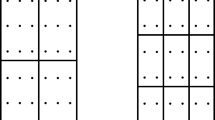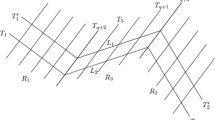Abstract
In 1779 Euler proved that for every even n there exists a latin square of order n that has no orthogonal mate, and in 1944 Mann proved that for every n of the form 4k + 1, k ≥ 1, there exists a latin square of order n that has no orthogonal mate. Except for the two smallest cases, n = 3 and n = 7, it is not known whether a latin square of order n = 4k + 3 with no orthogonal mate exists or not. We complete the determination of all n for which there exists a mate-less latin square of order n by proving that, with the exception of n = 3, for all n = 4k + 3 there exists a latin square of order n with no orthogonal mate. We will also show how the methods used in this paper can be applied more generally by deriving several earlier non-orthogonality results.
Similar content being viewed by others
References
Dénes J, Keedwell AD (1974) Latin squares and their applications. Academic Press
Dénes J, Keedwell AD (1991) Latin squares: new developments in the theory and applications, Annals of Discrete Mathematics, vol 46. North Holland
L Euler (1923) ArticleTitleRecherche sur une nouvelle espèce de quarrès magiques Leonardi Euleri Opera Omnia 7 291–392
AB Evans (1992) ArticleTitleThe existence of complete mappings of finite groups Congr Numer 90 65–75 Occurrence Handle0794.20034 Occurrence Handle1208964
M Hall LJ Paige (1955) ArticleTitleComplete mappings of finite groups Pacific J Math 5 541–549 Occurrence Handle79589 Occurrence Handle0066.27703
E Maillet (1894) ArticleTitleSur les carrés latin d’Euler C R Assoc France Ave Sci 23 IssueID2 244–252 Occurrence Handle26.0205
HB Mann (1944) ArticleTitleOn orthogonal latin squares Bull Amer Math Soc 50 249–257 Occurrence Handle0060.32307 Occurrence Handle10401 Occurrence Handle10.1090/S0002-9904-1944-08127-5
HW Norton (1939) ArticleTitleThe 7× 7 squares Ann Eugenics 9 269–307 Occurrence Handle0022.11102 Occurrence Handle1220
van Rees GHJ (1990) Subsquares and transversals in latin squares. Proc Twelfth British Combinatorial Conf. (Norwich, 1989), Ars Combin 29 B:193–204
A Sade (1951) ArticleTitleOmission dans les listes de Norton pour les carrés 7× 7 J Reine Angew Math 189 190–191 Occurrence Handle0045.15202 Occurrence Handle46997
IM Wanless BS Webb (2006) ArticleTitleThe existence of latin squares without orthogonal mates Des Codes Crypto 40 131–135 Occurrence Handle05075340 Occurrence Handle2226288
Author information
Authors and Affiliations
Corresponding author
Additional information
Communicated by D. Jungnickel
Rights and permissions
About this article
Cite this article
Evans, A.B. Latin Squares without Orthogonal Mates. Des Codes Crypt 40, 121–130 (2006). https://doi.org/10.1007/s10623-006-8153-3
Received:
Accepted:
Issue Date:
DOI: https://doi.org/10.1007/s10623-006-8153-3




